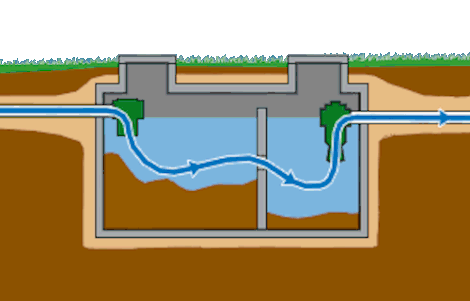|
15/2/2019 3 Comments septic systems: the inside story Two Components Class 4 septic systems are divided into two components, the septic tank and the septic field or leaching bed. Waste is piped out of the house into the septic tank, which is essentially a water clarification tank, in which anaerobic bacteria break the waste down into solids (sludge), liquid effluent, and scum. Septic System The solids settle to the bottom, the scum floats to the top and the liquid effluent flows through an outlet pipe into a distribution chamber, where it is directed to the septic field. The septic field is an effluent water disposal system, where the liquid is channeled through perforated pipes to different parts of a field of loose gravel. Septic tank materials that initially float in the scum layer are kept out of the drainage system by an outflow tee or baffle. If the tank is not pumped regularly, the level of solids can rise, and if it approaches the level of the outflow tee, scum and solids can proceed out into the drainage system, clogging the pipes and gravel - and eventually preventing the absorption of the water by the surrounding earth. A Class 5 septic system is a holding tank for the storage of sewage at the site where it is produced. A typical holding tank system is comprised of a single compartment tank with a pump-out stack and an audible or visual warning device to alert the homeowner when the tank requires emptying. A holding tank is costly to operate, places restrictions of the owner, and is dependent on Class 7 (hauled) sewage system for waste collection and disposal.
A property served by a holding tank system requires an agreement registered on title to notify current and future owners of the servicing restrictions on the property. Care and Maintenance
Helpful Hints
General Guidelines for Purchasers
The only way to make an accurate determination of the system is to have a licensed septic contractor perform a tank, distribution chamber and field inspection.
3 Comments
24/3/2023 06:03:34 pm
Great illustration of the components of a septic system. I am going to link back to this page so my clients can view that information. Thank you!
Reply
Mak
3/9/2023 09:55:33 am
Great work on your blog post! The content was engaging and informative, and I found the anecdotes and personal stories you shared to be relatable and impactful. To explore more, <a href="https://a925egulxgiw8w1pqey8o3zu65.hop.clickbank.net" target="_blank">click here</a>.
Reply
Archit Mehta
15/10/2023 05:44:39 am
Thank you for addressing the common challenges and providing practical solutions in your post. It's helpful and informative. For more information, <a href="https://4d09fzv4qpbs0rfomg8boe9seg.hop.clickbank.net" target="_blank">click here</a>.
Reply
Leave a Reply. |
AuthorGil Strachan is a professional home inspector, representing Electrospec Home Inspection Services in east-central Ontario since 1994. CategoriesAll Appliances Buying And Selling Cooling Electrical Environmental Exterior Health And Safety Heating Home Improvement Home Inspection Insulation Insurance Interior Plumbing Roofing Special Structure Archives
January 2024
|





